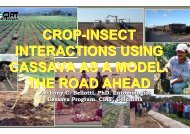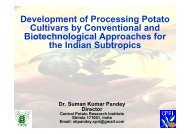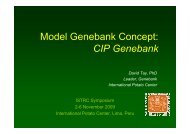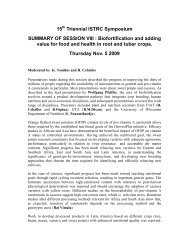Tsegaye, E.; New Potato (Solanum tuberosum L.)
Tsegaye, E.; New Potato (Solanum tuberosum L.)
Tsegaye, E.; New Potato (Solanum tuberosum L.)
Create successful ePaper yourself
Turn your PDF publications into a flip-book with our unique Google optimized e-Paper software.
<strong>New</strong> <strong>Potato</strong> (<strong>Solanum</strong>(<strong>tuberosum</strong> L.) VarietyReleased for the Highlands of SouthernEthiopiaEngida <strong>Tsegaye</strong> 1 , Atnafua Bekele 1 , Mihertu Cherinet 1 & TesfayeTadesse 1Southern Agricultural Research Institute P.O. Box 06, Awassa1Corresponding author, e-mail: eetaz2003@yahoo.comA Paper Presented to ISTRC Symposium: Tropical Roots and Tubersin a Changing Climate. A Critical Opportunity for the World.2 -66 Nov 2009
INTRODUCTION Human population estimated: 14.1 million (2004) Population density: 4 to 900 persons per km -2\ About half of the total population- mid- and high-altitude areas: only2.82% of the total area >70% of farmers- below 2 hectares RF pattern: bimodal with “belg”- Feb to April and “Meher”-Jun to August(main rainy season) The mean annual rainfall: 500 - 2200 mm The annual mean temperature: 15 - 30 0 C <strong>Potato</strong> is produced in both seasons
Economically important food and cash cropsupply high qulity food within a relatively short periodIt is becoming an excellent cash crop in the regionIt ranks third both in area planted and in production next to Enset[Ensete ventricosum(Welw) Cheesm] and sweet potatoIn 2008:• <strong>Potato</strong> occupied - 7490 ha of land• Production- 579530.4 tonsHadiya, Gurage, KAT, Wolayita, Gamo Gofa, Sidama and Gediozones account for over 95% of the total area and total productio• Productivity- 7.7 t/ha; national 8 t/ha
Released varieties: 25-45 t/ha• <strong>Potato</strong> varieties at the hands of most farmers are poor yielder &susceptible to diseasesCrop varieties are continuously needed under changingenvironmentAccordingly selection work had been undertaken from theadvanced clones Objectives:Developing high yielding and disease/insect peststolerant/resistant cultivars adaptable to Mid and highlands ofSouthern Ethiopia.
Materials and Methods• Treatments: Eight promising potato clones with one standard andone local check• Locations: Awassa, Bulle, Kokate & Chencha• Duration: Two consecutive years(2004 & 2005)• Design: RCB replicated three times• Plot size: 3X3m Spacing: 75cmX30cm• Fertilizers: DAP and UREA, 195 and 165 kg ha -1 , respectively• Data: On yield, yield components and disease incidence• Combined analysis of variance was carried out for tuber yields usingMSTAT.
Homogeneity of error variances over years and locations were tested ted asper Gomez and Gomez (1984)The square root of yield was analyzed instead of the actual yield d then thegenotypes mean values were back transformed.Analysis of stability- Eberhart and Russell (1966)One best performing & stable variety verified along with standard andlocal check varieties at 12 locations for releasePlot size 10mx 10m at each locationData was recorded on marketable & total tuber yields
RESULTS AND DISCUSSION●●There were significant differences among the clones for bothmarketable and total tuber yields.Genotype by location (GXE) interaction was also highlysignificant
Table 1 Combined Analysis of variance for tuber yields in ten potatoclones tested at four locations during 2004 and 2005.05.SourceDFMarketable tuber yieldTotal tuber yieldLocation(L)3155.32 **148.73 **Year(Y)111.53 **18.08 **YxL37.33 **7.75Genotype (G)95.75 **5.56 **YxG90.76 *0.56 **LxG270.96 **0.90 **LxYxG270.88 **0.77 **Error1580.340.35**. * Significant at 1% and 5% probability level, respectively.
Table 2. Mean marketable tuber yields (t ha-1) of ten potato clones tested at four locations durin2004 and 200520042005ClonesAwasKokateBulleCh.MeanAwassaKokateBulleCh.MeanMean GXLCIP-389703.321.3046.6732.966.7226.9119.3123.1542.133.1521.9424.42 CDCIP-385021.4424.0730.7437.505.1924.3813.8028.8943.704.6322.7623.57 DCIP-387679.1715.5648.2439.547.1327.6226.2019.6343.895.8423.8925.75 BCDCIP-385021.2625.8349.6350.6512.7834.7215.8322.0346.116.9422.7328.73 ABCIP-385383.1228.9842.0337.5010.8329.8423.2430.9342.222.8724.8227.33 BCCIP-392618.51130.3750.4634.2613.4232.1316.8538.0554.818.8029.6330.88 ACIP-392640.51316.1147.2731.787.6925.7119.8237.8727.683.6122.2523.98 CDKP-90138.128.9840.6933.808.6128.0216.3434.2639.264.4423.5825.80 BCDWechecha18.1524.0723.614.9117.6917.5017.3140.284.3519.8618.77 ELocal check13.8922.7821.113.6115.3521.1610.9222.223.5214.4614.90 FCV (%)16.5517.7018.8424.9026.7416.3024.1518.7512.84LSD(0.05)6.3312.2311.073.468.727.3716.671.55Means followed by the same letter are not significantly different at 5% probability level
Table 3. Stability analysis of genotypes for tuber yield across fourlocationsClonesMeanRegressioncoefficientMSdeviationCoefficients ofdetermination1CIP-389703.325.401.1 ± 0.04-4.9760.99872CIP-385021.4424.571.069 ± 0.2512.074*0.94933CIP-387679.1727.821.097 ± 0.1-1.130.98774CIP-385021.2629.771.155 ± 0.3223.59**0.92955CIP-385383.1228.411.088 ± 0.11-1.820.98956CIP-392618.51131.981.171 ± 0.194.640.9757CIP-392640.51325.411.020 ± 0.4861.77**0.81628KP-90138.127.111.052 ± 0.151.0580.97999Wechecha19.120.721 ± 0.195.090.933910Local check16.110.527 ± 0.228.160.8544G. Mean25.57SD error of mean±2.33*, ** significant at 5% and 1% probability level, respectively.
Table 4 Marketable and total tuber yields of four potato varietiesesverified at eight farmers’ field in the year 2009Marketable tuber yield ( t/ha)varietyAwassaKokateChenchaBulleMeanFarmer1Farmer2Farmer1Farmer2Farmer1Farmer2Farmer1Farmer2CIP-392618.51124.4227.8824.7143.2932.5935.0638.1749.4634.45Maracharie14.3227.7629.1832.2431.2934.9427.5728.4128.21Wechecha14.8126.0023.0630.1230.4732.8229.1040.1528.32Local Check6.3214.007.2428.123.657.6517.3027.2613.94Total tuber yield ( t/ha)CIP-392618.51127.3533.2425.4444.2432.8835.6538.1750.5735.94Maracharie16.3630.3530.1532.9432.2935.7633.0144.0431.86Wechecha16.3329.5323.6531.2930.5833.1829.1040.7629.30Local Check6.9915.658.0629.184.7410.0018.7328.1415.18
Table 5. The reaction of different potato clones to late blight diseaseincidence at four locations in 2004 and 2005Disease incidence (%)CloneKokateChenchaAwassaBulleMean1CIP-389703.317.30.026.50.711.12CIP-385021.4416.90.735.80.013.33CIP-387679.1718.10.051.51.717.84CIP-385021.2613.80.051.70.016.45CIP-385383.1211.60.317.20.07.36CIP-392618.5119.10.016.30.06.47CIP-392640.51315.71.029.01.711.98KP-90138.19.22.012.00.76.09Wechecha15.81.330.70.012.010Local check34.817.748.815.029.1
CONCLUSION• The clone CIP-392618.511 approved byNational Crop Variety Releasing Committee torelease for production in the Mid and highlandsof Southern Ethiopia as of the year 2009• Currently, the variety is under multiplication fordemonstration and dissemination in major potatogrowing areas of Southern Ethiopia.
Acknowledgements• CIP (Sub-Saharan Africa Branch office) and HoletaAgricultural Research Center- for provision ofplanting materials• Harvest Plus -for sponsoring to attendISTRC symposiumHorticulture staff of Awassa Agricultural ResearchCenter - for their careful attendance of theexperiment.











